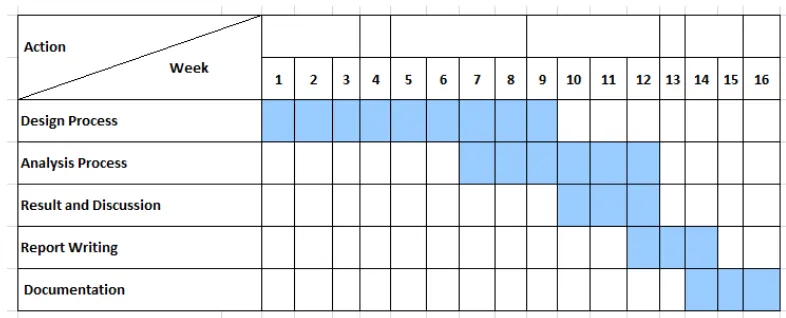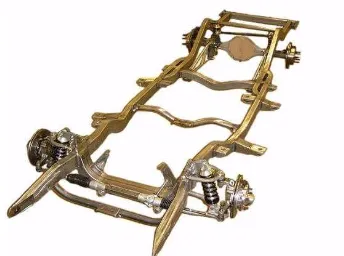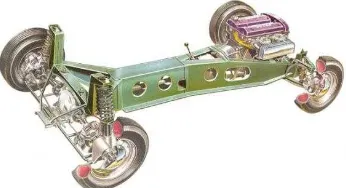STUDIES AND DESIGN OF CARBON FIBER MONOCOQUE CHASSIS FOR FORMULA SAE RACING CAR
MOHD SAUFI BIN AMRAN
“I hereby verify that I have read this report and I find it sufficient in term of quality and scope to be awarded with the Bachelor Degree in Mechanical Engineering”
Signature :………. Supervisor 1 Name :……… Date :………
STUDIES AND DESIGN OF CARBON FIBER MONOCOQUE CHASSIS FOR FORMULA SAE RACING CAR
MOHD SAUFI BIN AMRAN
Laporan ini dikemukakan sebagai memenuhi sebahagian daripada syarat penganugerahan Ijazah Sarjana Muda Kejuruteraan Mekanikal
(Automotif)
Fakulti Kejuruteraan Mekanikal Universiti Teknikal Malaysia Melaka
“I admit that this report is from my own work and idea except for the summary and a few section which were extracted from other resources as being mention”
iii
DEDICATION
ACKNOWLEDGEMENT
v
ABSTRACT
ABSTRAK
vii
TABLE OF CONTENTS
CHAPTER CONTENTS PAGE
CONFESSION ii
ACKNOWLEDGEMENT iii
ABSTRACT iv
ABSTRAK v
TABLE OF CONTENTS vii
LIST OF TABLES x
LIST OF FIGURES xi
LIST OF SYMBOLS xiv
LIST OF APPENDIX xv
1 INTRODUCTION
1.1Background of the Project 1
1.2Objective and Scope 2
1.3Problem Statement 3
1.4PSM Schedule 4
2 LITERATURE REVIEW
2.1 Chassis Technology 5
2.2 Overview of Chassis Types 6
2.2.1 Ladder Chassis 6
2.2.2 Tubular Chassis 6
2.2.3 Backbone Chassis 7
2.2.5 Space Frame 8
2.2.6 Monocoque Chassis 9
2.3 Load Cases 10
2.3.1 Torsional Stiffness 11
2.4 Carbon Fiber Technology 12
2.4.1 Production Process 14
2.4.2 Molding Methods 16
2.5 Resin Types 16
2.6 Core Material 17
2.7 Computer Aided Design 21
2.8 Computer Aided Engineering 22
3 METHODOLOGY 24
3.1 Introduction 24
3.2 Design Constraints 26
3.2.1 Vehicle Requirement 26
3.2.1.1 Body and Vehicle Configuration 26
3.2.1.2 Ground Clearance 27
3.2.2 Material requirement 27
3.2.2.1 Material Selection 27
3.2.3 Strength requirement 28
3.2.4 Safety Requirement 29
3.2.4.1 Main Hoop 29
3.2.4.2 Front Hoop 30
3.2.4.3 Side Impact Protection 30
3.2.4.4 Impact Attenuator 30
3.2.5 Component Restraints 32
3.2.5.1 Engine/Drive Train 32
3.2.5.2 Suspension 32
3.2.5.3 Cockpit dimensions and control location 32
3.3 Design Criteria 33
3.3.1 Dimensions 33
3.3.2 Applied Loads 34
ix
3.3.2.2 Dynamic Loads 37
3.4 Design Process 37
3.4.1 Sketching Process and Preliminary Design 38 3.4.2 Design Analysis (FEA) and Redesign 40
3.4.2.1Type of testing 42
3.4.2.1.1 Torsional Stiffness 42 3.4.2.1.2 Longitudinal Rigidity 44 3.4.3 Final Design Refinement and Completion 44
3.5 CATIA CAD Modeling 45
3.6 CAE Modeling 45
3.6.1 Finite Element Analysis Step 46
4 RESULT AND DISCUSSIONS 52
4.1Introduction 52
4.2 Torsional Stiffness Analysis Result 52 4.2.1 Analysis Result – Second Concept Design 55 4.2.2 Analysis Result – Third Concept Design 57
4.3 Discussion 59
4.4 Longitudinal Rigidity Result 60
4.5 Center of Gravity 61
4.6 Compliance to Rules 62
5 CONCLUSION AND RECOMMENDATION 64
5.1 Conclusion 64
5.2 Recommendation for Future Study 65
REFERENCES 67
BIBLIOGRAFY 68
APPENDIX A 69
APPENDIX B 82
LIST OF TABLES
NO. TITLE PAGE
2.1 The categories of carbon fiber 14
2.2 Advantages and Disadvantages of Common 18 Thermosetting Resins Used in Structural
Composites.
3.1 Comparisons of relative specific stiffness and strength 29
3.2 Total Mass of FSAE Monocoque Chassis 34
3.3 Calculation of Axle Loads 36
3.4 Surface Areas for Different Chassis Configurations 39
3.5 Material Properties for CFRP 41
3.6 Properties of Aluminium Honeycomb 41
xi
LIST OF FIGURES
NO. TITLE PAGE
1.1 Gantt Chart for PSM I 4
1.2 Gantt Chart for PSM II 4
2.1 Chevy Ladder Chassis 6
2.2 The Tubular Chassis of The 3500 Gt 7
2.3 1962 Lotus Elan Backbone Chassis 7
2.4 Space Frames Chassis 8
2.5 Monocoque Chassis 9
2.6 Achieving the Same Result 10
2.7 Bending Load Case 10
2.8 Torsion Load Case 11
2.9 Torsional Stiffness Measurement 12
2.10 Carbon Fiber Reinforcement Plastic 14
2.11 The Wet Layup Process to Produce Carbon Fiber 15 Paddle
2.12 Cored Laminate under a Bending Load 18
2.13 Honeycomb Sandwich Panel Compared To 19 An I-Beam
2.14 Nomex Honeycomb 20
2.15 Aluminium Honeycomb 20
3.1 Flow Chart of Methodology 25
3.2 Carbon Fiber/Epoxy with Aluminium 28
Honeycomb Cross Section
3.3 Chassis Restriction 31
3.5 Dimensions of Formula Sae Monocoque Chassis 34 3.6 Load Distribution for FSAE Monocoque Chassis 35
3.7 First Concept Design 38
3.8 Second Concept Design 38
3.9 Third Concept Design 39
3.10 Final Design 40
3.11 Load Cases and Boundary Condition for Torsional 43 Stiffness
3.12 Load Cases and Boundary Condition for Longitudinal 44 Rigidity
3.13 The FSAE Monocoque Chassis in Catia interface 45
3.14 Model of Fsae Monocoque Chassis in 46
Msc Patran
3.15 Boundary Condition of Model 47
3.16 Applied Load on the Model 47
3.17 Material Properties 48
3.18 Model with Finite Element Mesh 48
3.19 Plot of Element Normal Vectors 49
3.20 Illustration of Element Normal Force 49 3.21 Toolbar For Verify Of Element Normal Vector 50 3.22 The Element Normal Vector after Verification 50 4.1 First Concept Design Model in Msc Patran 53 4.2 Displacement Analysis Result for First 53
Concept Design
4.3 Stress Analysis Result for First Concept Design 54
4.4 Second Concept Model in MSC Patran 55
4.5 Displacement Analysis for Second 55
Concept Design
4.6 Resulted of Second Concept Design 56
after Modification
4.7 Stress Analysis Result for Second 56
Concept Design
xiii
4.9 Stress Analysis Result for Third Concept Design 59 4.10 Displacement Analysis for Third Concept Design 59 4.11 Final Design Chassis with Longitudinal 61
Rigidity Test
4.12 Center of Gravity of Chassis 62
4.13 “Percy” – 95th Percentile Male with Helmet 63 4.14 The test dummy modeled to test for clearance 63
from role hoops
LIST OF SYMBOLS
C = Torsional Stiffness in N/Mm c = Spring Rate
d = Road Wheel Deflection
D = Torsional Deflection of Chassis Pc = Load Composite
Pf = Load Fiber Pm = Load Matrix
xv
LIST OF APPENDIX
NO. TITLE PAGE
1 Formula SAE 2009 Rules 69
2 Technical Drawing for Carbon Fiber Monocoque 82 Chassis of FSAE
CHAPTER 1
INTRODUCTION
1.1 Background of Project
2
1.2 Objective and Scope
a) Objective:
The main objectives of this project were:
a) To design the FSAE monocoque chassis by going through all the important related processes and regulations;
b) To design the monocoque chassis using carbon fiber as main material;
c) To develop the concept of chassis and its application, and discover CAD and CAE tools. On the other hand, the production process and performance of carbon fiber also need to be taken into account;
d) To perform a torsion test on the chassis to determine its torsional stiffness.
Scope:
a) To study the information related to the carbon fiber monocoque chassis of FSAE;
b) To design the chassis of FSAE racing car by considering the input gained during the literature stage, in term of strength requirements and reliability requirements;
1.3 Problem Statement
4
[image:21.612.136.530.124.319.2]1.4 Project Schedule
Figure 1.1: Project Schedule for PSM I
[image:21.612.131.524.385.544.2]CHAPTER 2
LITERATURE REVIEW
2.1 Chassis Technology
Brown et al. (2005) stated that the chassis is the framework which provides mounting points for the suspensions systems, steering mechanism, engine and gearbox, the final drive, the fuel tank and the seating for the occupants. A body is built on the chassis to complete the vehicle. Chassis has to provide sufficient rigidity for accurate handling, absorb crash energy for the safety of the occupants, and resist torsional and bending deflection. It also needs to be light enough to increase fuel economy and speed and to reduce inertia, thereby increasing the performance of car.
6
2.2 Overview of Chassis Types
2.2.1 Ladder Chassis
[image:23.612.256.428.304.432.2]Ladder Chassis is the earliest kind of chassis. It’s have a good isolation between passenger cabin and road vibration making its still used in trucks and SUVs. It has two longitudinal rails interconnected by several lateral and cross braces. The advantages of this type of chassis are its easy and cheap hands build. However, Brown et al. (2005) stated that since it is a 2 dimensional structure, torsional rigidity is very much lower than other chassis, especially when dealing with vertical load or bumps.
Figure 2.1: Chevy Ladder Chassis (Source: www.autoweldchassis.com)
2.2.2 Tubular Chassis
Figure 2.2: The tubular chassis of the 3500 GT (Source: www.maserati-alfieri.co.uk)
2.2.3 Backbone Chassis
Backbone chassis is a simple chassis with a strong tubular backbone (usually in rectangular section) connects the front and rear axle. There is space for the drive shaft in case of front-engine, rear-wheel drive layout. The whole drivetrain, engine and suspensions are connected to both ends of the backbone. Brown et al. (2005) agreed that this chassis provides nearly all the mechanical strength and strong enough for smaller sports cars. It is also easy to be made by hand thus cheap for low-volume production. With its simple structure, it is become the most space-saving other than monocoque chassis. The disadvantages are it is not strong enough for high-end sports cars. The backbone does not provide protection against side impact or off-set crash. It is also cost ineffective for mass production.
[image:24.612.242.415.589.683.2]

